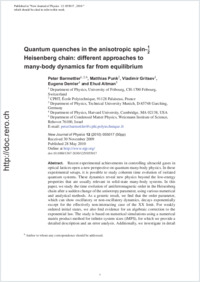Quantum quenches in the anisotropic spin-\frac{1}{2} Heisenberg chain: different approaches to many-body dynamics far from equilibrium
- Barmettler, Peter Department of Physics, University of Fribourg, Switzerland - CPHT, École Polytechnique, Palaiseau, France - Department of Physics, Technical University Munich, Garching, Germany
- Punk, Matthias CPHT, École Polytechnique, Palaiseau, France - Department of Physics, Technical University Munich, Garching, Germany
- Gritsev, Vladimir Department of Physics, University of Fribourg, Switzerland
- Demler, Eugene Department of Physics, Harvard University, Cambridge, USA
- Altman, Ehud Department of Condensed Matter Physics, Weizmann Institute of Science, Rehovot, Israel
-
28.05.2010
Published in:
- New Journal of Physics. - 2010, vol. 12, p. 055017
English
Recent experimental achievements in controlling ultracold gases in optical lattices open a new perspective on quantum many-body physics. In these experimental setups, it is possible to study coherent time evolution of isolated quantum systems. These dynamics reveal new physics beyond the low-energy properties that are usually relevant in solid-state many-body systems. In this paper, we study the time evolution of antiferromagnetic order in the Heisenberg chain after a sudden change of the anisotropy parameter, using various numerical and analytical methods. As a generic result, we find that the order parameter, which can show oscillatory or non-oscillatory dynamics, decays exponentially except for the effectively non-interacting case of the XX limit. For weakly ordered initial states, we also find evidence for an algebraic correction to the exponential law. The study is based on numerical simulations using a numerical matrix product method for infinite system sizes (iMPS), for which we provide a detailed description and an error analysis. Additionally, we investigate in detail the exactly solvable XX limit. These results are compared to approximative analytical approaches including an effective description by the XZ model as well as by mean-field, Luttinger-liquid and sine-Gordon theories. The comparison reveals which aspects of non-equilibrium dynamics can, as in equilibrium, be described by low-energy theories and which are the novel phenomena specific to quantum quench dynamics. The relevance of the energetically high part of the spectrum is illustrated by means of a full numerical diagonalization of the Hamiltonian.
- Faculty
- Faculté des sciences et de médecine
- Department
- Département de Physique
- Language
-
- English
- Classification
- Physics
- License
- License undefined
- Identifiers
-
- RERO DOC 20261
- DOI 10.1088/1367-2630/12/5/055017
- Persistent URL
- https://folia.unifr.ch/unifr/documents/301646
Statistics
Document views: 82
File downloads:
- bar_qqa.pdf: 158
